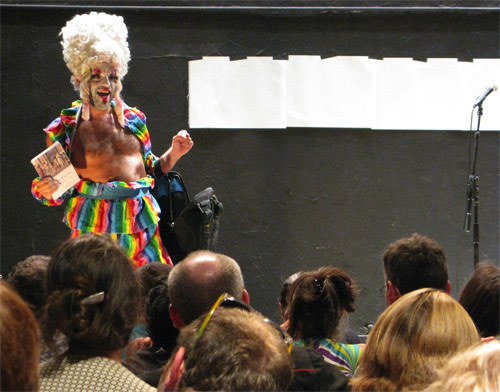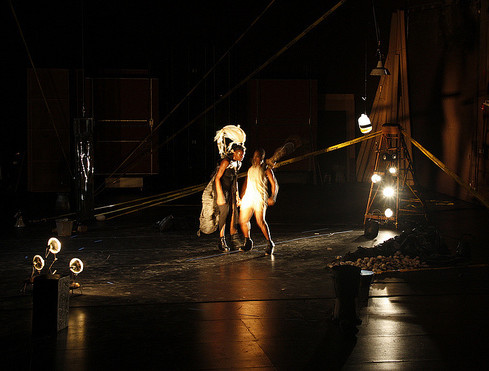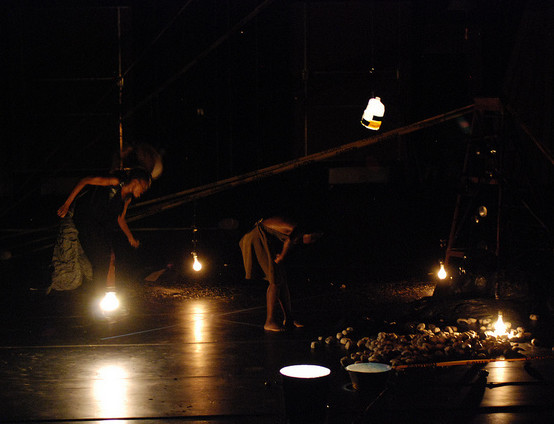TBA Day 4: Contrasting Review of Miguel Gutierrez + Nora Chipaumire
Miguel Gutierrez and Nora Chipaumire might both be artists currently based in New York with roots in modern dance, but the drive from Gutierrez’s HEAVENS WHAT HAVE I DONE to Chipaumire’s Miriam was more than just a journey across town—it was a journey across a spectrum from light to darkness and from self-revelation to self-obfuscation.

Gutierrez, who’s show Last Meadow was a critical favorite at TBA:09, started his performance by walking on stage at Washington High School in jeans, an old gas station sweatshirt with stampeding horses, and drag queen clown makeup. Announcing that the show had already begun, he asked that the entire audience get up and sit on stage cross-legged, creating the sense of Miguel story time. And Miguel-focused story time it was, as he launched into a very stream of consciousness telling of how the show came to be (it was commissioned for a French showing that never came to be). “This piece was never meant to be an official piece,” he said.
That statement basically summed up the first two-thirds of the performance. Miguel chatted, walking off stage mid sentence to get mic stands and suitcases full of props; walking off thought mid sentence to digress into another story or thought; peppering his monologue with sometimes humorous quips (“This show is very 80s, which is good, because the 80s are always in style"). Along the way, as he changed into what looked like a rainbow pride flag sewn into a clown outfit (by the deliciously over-the-top New York designer Machine Dazzle, Gutierrez shares), he dropped clues about the piece and it’s meaning—or lack thereof. “If you’re a curator or a critic or a graduate student, don’t analyze this part,” he said as he scattered coins across the stage. “I did not become an artist so I could make sense.”
Then the piece took a turn as he donned a cheap Marie Antoinette wig and started to spout French translations into the mic, looping his voice and ultimately degrading the sound into a tempest of noise, to which he executed an angry tango style dance, strutting back and forth behind the audience. Next, with great strength and beauty, he sang along with Cecilia Bartoli’s recording of "Sposa son disprezzatta." Finally, he trailed off saying how thankful he was that we had come. He had taken us from the very naked depiction of a show's creation to a highly costumed explosion of so-called "high art."
The parallels between the piece and Keith Hennessy’s solo Crotch, which Hennessy performed here in June, were palpable. Both started with the artist in civvies informally inviting us into the show and onto the stage, sharing very personal stories. Both had faux-didactic moments of philosophy and theory. Both mixed in isolated moments of modern dance and nonsensical moments of absurdity. (Gutierrez told me this morning that when he saw Crotch for the first time last year, he thought, “damn, I just made the same piece!”) Of course, there're many differences, too. But whereas I found that Hennessy’s engagement with the audience created an incredible sense of intimacy and shared risk, I found Gutierrez’s strangely distancing. His nonstop chatter felt like an uncomfortable date with an increasingly manic clown who’s afraid of silence—in effect building an artifice of words to compliment the physical artifice of the clown makeup. He writes in the program that: “This piece was originally going to be called A conversation that starts as a conversation but then becomes something else.” What that something else is never becomes quite clear, creating a dissonance between the sense of joyful personal revelation and the feeling at the end that you're not at all certain what was just revealed and to what end.
At the same time, if we take Gutierrez at his word, it could simply be a riotous romp through the truth and bullshit that is the act of making art. It doesn’t require any "deeper" meaning—it is instead a window into the artist's creative process, with all it's neuroses, experimentation, and chaos. Certainly Gutierrez has plenty enough charm to hold your attention. Nonetheless, I left feeling entertained but unsatisfied, like it never fully came together.
(Editor's note: To be fair, both the Oregonian and the Mercury found the show much more successful.)
You have one more chance to catch Gutierrez tonight at 6:30 at Washington High School.

In drastic contrast, Chipaumire’s performance was cloaked in darkness, shadows, and obfuscation from the outset. Opening with dancer Okwui Okposwasili moving across the stage with only a headlamp cutting through the darkness, we slowly got glimpses of a mysterious stage of ladders, caution tape, upended buckets, and piles of stones and plastic rubbish. After Okposwasili climbed the ladder, one of the piles began to stir, making sounds in two opposing registers: high-pitched, pterodactyl-like squawks (sometimes we make out the word “smile”) and deep-throated growls, occasionally finding the words “you must get up.” As Chipaumire emerged, Okposwasili turned on a hanging overhead lamp, offering enough light to give the set the sense of a basement jail, a prison camp at night, or a dark alley crime scene. Then she began to bark movement commands via a bullhorn: “face front,” “feminist walk,” “quarter turn to your right.”
Ostensibly, the piece is an exploration of three Miriams—the Virgin Mary, the sister of Moses, and the iconic South African singer Miriam Makeba—along with stereotypes and tensions around the black female body (read what Chipaumire had to say about it at yesterday’s artist talk), executed obliquely between the two dancers, who sometimes seem captor/prisoner, sometimes mother/daughter, sometimes sisters, and sometimes ritual dancers. Incorporated are various further iconography of traditional and contemporary Africa: ululations, whistles, lit up plastic jugs, and bare light bulbs. But it’s an exploration cloaked in darkness (inspired in part by Joseph Conrad’s Heart of Darkness), where the dangerous sense of the unknown and the “other” of Africa are explicitly recreated.

It’s almost impossible to describe the rest of the show, in large part because it’s so dark that half the time the audience can’t really see what’s happening. The costumes (which look equal part exotic bird and strange dinosaur), set, and surround sound design are all gorgeously complex, although so obscured by darkness and sound layers that we never fully enjoy them (Chipaumire said yesterday that the obfuscation is intentional). In a few places of clarity, the text was beautiful and profound (“She was savage and superb; wild eyed and magnificent,” Okposwasili said at one point of Chipaumire/Miriam). And the dance—hinging, gyrating, and originating mostly from the hips—was a marriage of African and modern that created a strange sense of dystopian ritual (if Heart of Darkness is a classic source of inspiration, I feel like the closest contemporary analogue, at least aesthetically in terms of set and costumes, is the underground setting for the human rebels in The Matrix movies).
I really wanted to love the piece—it hinted at something so visually stunning and complex—and I think I would have if only I could have seen more. (Chipaumires said it’s supposed to be performed in the round in a smaller space, which I think could’ve made all the difference, as it really is a performance directed along all axes as opposed to being directed towards an audience in front—and perhaps being close would alleviate the lack of light issue.) But ultimately the decision to cloak it so deeply in darkness, though I appreciate the intention, backfired for me. It served too much like a burlesque tease, giving glimpses of something heavy and majestic, but never offering anything approaching a full enough reveal to reward the audience's patient waiting.
While neither piece alone felt like a full meal, the richness of the night came in enjoying the contrast between how two performers explored their personal and cultural iconography, particularly when thought of as courses that were topped off with the dessert of Ten Tiny Dances (look for a recap tomorrow).
